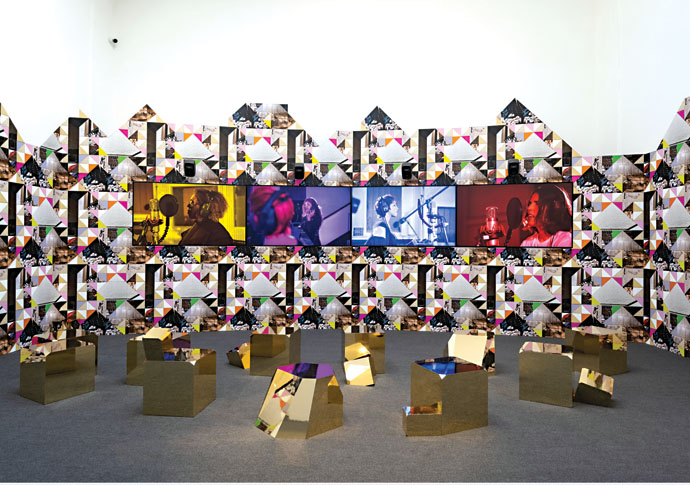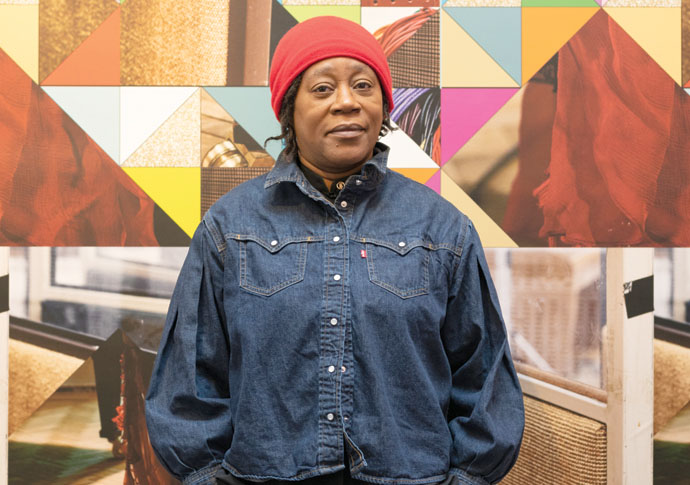Venetian class
Sonia Boyce went to Venice bent on inspiring joy – and came back with the Biennale’s top prize, writes Angela Cobbinah
Thursday, 26th January 2023 — By Angela Cobbinah

Sonia Boyce: Feeling Her Way featuring performers Errollyn Wallen, Tanita Tikaram, Poppy Ajudha and Jacqui Dankworth. Photo: Cristiano Corte © British Council
LAST year Sonia Boyce won the Venice Biennale’s top prize, the first black woman to represent the UK and the first Brit to win it in more than a quarter of a century. Next month her winning installation, Feeling Her Way, is coming to the Turner for its UK debut, giving people a chance to see how an artist who started out as a figurative painter has ended up expressing herself through a dizzying mix of film, collage, sculpture, music and memorabilia.
Although Boyce was already a name, having been one of the youngest artists to enter the Tate Collection in 1987 and in 2016 becoming the first black woman to be elected to the Royal Academy, being chosen to showcase her work at the 59th Biennale came out of the blue.
“With other types of awards or commission, artists usually have to put together a portfolio and proposal – make their pitch. This makes it a particular kind of surprise as I wasn’t aware I was even being considered,” she tells me.
As for actually topping the most prestigious art show in the world with the Golden Lion for Best National Participation, that was also way off her radar. “I was particularly humbled as, again, I never expected to be in the running. The Golden Lion is a huge deal. It’s equivalent to the Hollywood Oscars, but for the art world. I was actually shaking when I went up to receive the award.”
Born in London in 1962, Boyce emerged in the 1980s as a leading light of the Black Arts Movement after going through art college unaware that there were artists of African or Asian descent working in the UK at all. Discovering otherwise was a lightbulb moment and her early work reflected her experience of growing up the child of West Indian migrants in a society that placed black people on the very margins, not least black women.
I first met Boyce in 2013 with images of her striking Frida Kahlo-inspired oil pastels in my mind, only to discover that she had left all that behind many years earlier.
Instead she guided me around her latest exhibition, a startling multi-media presentation arising out of the Devotional Collection, her archive of black British women in the music industry that included hundreds of objects – CDs, cassettes, vinyls, DVDs and magazines – embellished with film and a wallpaper spread bearing the names of 200 musicians elaborately drawn in repetitive concentric lines.

Sonia Boyce – now a superstar in the art world. Photo: Cristiano Corte © British Council
The aim was to underline the contribution of the likes of jazz singer Adelaide Hall and pop diva Shirley Bassey, who, although hugely popular in their day, end up as mere footnotes in musical history or are sometimes entirely forgotten.
“My early works were very much concerned with discussions about painting, and finding appropriate representations of black life. This was very urgent at the time – it burned bright but fast for a few years,” she told me back then.
Instead, most of her 40-year career has been devoted to a more expansive form cultural activism using completely different mediums. “I abandoned drawing in a particular way,” she explains.
“All of my work involves the body – the figure. The shift that has occurred has been about inviting other people into the making of the artwork … I’m not sure why a change of medium – using video or sound, photographs or printmaking – makes the work appear so different to everyone. The biggest change for me has been to look outwards to see how people connect and sometimes disconnect.”
Devotional itself began as a collaborative project in 1999 and has gone through several versions as Boyce builds up her archive and continually interrogates what is meant by art. Traipsing around charity shops, eagerly taking in donated bits and pieces, venturing out with her mobile phone camera and working with other artists and performers, she is a woman on a mission, never afraid to let her imagination run away with her.
“The project has taken hold of me rather than the other way around,” she declares. “And, as an artist, once you have material you have to figure out what to do with it. So it’s been a gradual and intriguing progression.”
In her recent Just for the Record exhibition at the Simon Lee Gallery in Mayfair, co-sponsors of Boyce’s Biennale entry, items like cheaply produced fly posters and a CD cover of 80s pop duo Mel and Kim bearing a reduced £2.50 price sticker become fine art in Boyce’s hands. Put another way, it is the ultimate fan art.
Therein lie the roots of Feeling Her Way, which is centred on a video of five female musicians interacting with their voices.
Boyce describes her work as “social practice”, one that is concerned “with who and what we remember and, I hope, encourages others to play or explore beyond assumptions”.
Talking specifically about Feeling Her Way, which features the singer Jacqui Dankworth, the daughter of Cleo Laine, she adds: “My main interest in bringing the musicians together was to experience the skilfulness and emotional power of their voices.
“I wanted us all to acknowledge and connect with each other through the visceral beauty of music, the way it sits in our lives as a balm.”
Pointing out that this was the first Venice Biennale after two years of lockdowns, she says she wanted to create something emotionally joyful. “Also, the memorabilia of music that comes out of the Devotional project, was a way for the work to trigger memories in the audience about how women in the world of music have played out in each of our lives.”
With influences of Warhol and Dalí clearly to be seen, Boyce’s work is unconventional, engaging and combative all at the same time, rather like the artist herself. From being a rebel with a cause she is now a superstar of the art world, caught up in a whirlwind schedule that still has to make room for teaching, which she loves. When she’s finished with me she has to catch up on some reading material before her next PhD supervision session at the University of the Arts London, where she is professor of black art and design.
“I have been in the art world for 40 years and as such there are too many people to mention who have helped me on this journey,” she muses.
“As collaborators, other artists coming into my studio and me going into theirs, conversations with curators, writers and arts organisations, me continuing to be a cultural activist as a trustee on arts organisations, teaching and learning from the emerging generations – I’ve been busy.”
• Feeling Her Way opens at the Turner Contemporary, Margate, on February 4 and runs until May 8. Free entry